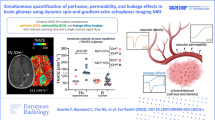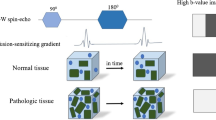Abstract
Objective
This study aimed to compare the accuracy of relative cerebral blood volume (rCBV) and percentage signal recovery (PSR) obtained from high flip-angle dynamic susceptibility contrast perfusion-weighted imaging (DSC-PWI) sequences with and without contrast agent (CA) preload for presurgical discrimination of brain glioblastoma and lymphoma.
Methods
Consecutive 336 patients (glioblastoma, 236; PCNSL, 100) were included. All the patients underwent DSC-PWI on 3.0-T magnetic resonance units before surgery. The rCBV and PSR with preloaded and non-preloaded CA were measured. The means of the continuous variables were compared using Welch’s t-test. The diagnostic accuracies of the individual parameters were compared using the receiver operating characteristic curve analysis.
Results
The rCBV was higher with preloaded CA than with non-preloaded CA (glioblastoma, 10.20 vs. 8.90, p = 0.020; PCNSL, 3.88 vs. 3.27, p = 0.020). The PSR was lower with preloaded CA than with non-preloaded CA (glioblastoma, 0.59 vs. 0.90; PCNSL, 0.70 vs. 1.63; all p < 0.001). Regarding the differentiation of glioblastoma and PCNSL, the AUC of rCBV with preloaded CA was indistinguishable from that of non-preloaded CA (0.940 vs. 0.949, p = 0.703), whereas the area under the curve of PSR with preloaded CA was lower than non-preloaded CA (0.529 vs. 0.884, p < 0.001).
Conclusion
With preloaded CA, diagnostic performance in differentiating glioblastoma and PCNSL did not improve for rCBV and it was decreased for PSR. Therefore, high flip-angle non-preload DSC-PWI sequences offer excellent accuracy and may be of choice sequence for presurgical discrimination of brain lymphoma and glioblastoma.
Clinical relevance statement
High flip-angle DSC-PWI using non-preloaded CA may be an excellent diagnostic method for distinguishing glioblastoma from PCNSL.
Key Points
• Differentiating primary central nervous system lymphoma and glioblastoma accurately is critical for their management.
• DSC-PWI sequences optimised for the most accurate CBV calculations may not be the optimal sequences for presurgical brain tumour diagnosis as they could be masquerading leakage phenomena that may provide interesting information in terms of differential diagnosis.
• High flip-angle non-preloaded DSC-PWI sequences render the best accuracy in the presurgical differentiation of brain lymphoma and glioblastoma.






Similar content being viewed by others
Abbreviations
- AIF:
-
Artery inflow function
- AUC:
-
Area under the curve
- BBB:
-
Blood-brain barrier
- CA:
-
Contrast agent
- CE-T1WI:
-
Contrast-enhanced T1-weighted image
- CNWM:
-
Contralateral normal-appearing white matter
- DSC-PWI:
-
Dynamic susceptibility contrast perfusion-weighted imaging
- FLAIR:
-
Fluid-attenuated inversion recovery
- ICCs:
-
Intraclass correlation coefficient
- PCNSL:
-
Primary central nervous system lymphoma
- PSR:
-
Percentage signal recovery
- rCBV:
-
Relative cerebral blood volume
- ROC:
-
Receiver operating characteristics curve
- ROI:
-
Region of interest
- SI:
-
Signal intensity
- TICs:
-
Time-intensity curves
References
Heming M, Haessner S, Wolbert J et al (2022) Intratumor heterogeneity and T cell exhaustion in primary CNS lymphoma. Genome Med 14:109
Lim M, Xia Y, Bettegowda C, Weller M (2018) Current state of immunotherapy for glioblastoma. Nat Rev Clin Oncol 15:422–442
Scordo M, Wang TP, Ahn KW et al (2021) Outcomes associated with thiotepa-based conditioning in patients with primary central nervous system lymphoma after autologous hematopoietic cell transplant. JAMA Oncol 7:993–1003
Welker K, Boxerman J, Kalnin A et al (2015) ASFNR recommendations for clinical performance of MR dynamic susceptibility contrast perfusion imaging of the brain. AJNR Am J Neuroradiol 36:E41-51
Xing Z, Kang N, Lin Y, Zhou X, Xiao Z, Cao D (2020) Performance of diffusion and perfusion MRI in evaluating primary central nervous system lymphomas of different locations. BMC Med Imaging 20:62
Choi KS, You SH, Han Y, Ye JC, Jeong B, Choi SH (2020) Improving the reliability of pharmacokinetic parameters at dynamic contrast-enhanced MRI in astrocytomas: a deep learning approach. Radiology 297:178–188
Kim HS, Kwon SL, Choi SH et al (2020) Prognostication of anaplastic astrocytoma patients: application of contrast leakage information of dynamic susceptibility contrast-enhanced MRI and dynamic contrast-enhanced MRI. Eur Radiol 30:2171–2181
Kickingereder P, Sahm F, Radbruch A et al (2015) IDH mutation status is associated with a distinct hypoxia/angiogenesis transcriptome signature which is non-invasively predictable with rCBV imaging in human glioma. Sci Rep 5:16238
Steidl E, Langen KJ, Hmeidan SA et al (2021) Sequential implementation of DSC-MR perfusion and dynamic [(18)F]FET PET allows efficient differentiation of glioma progression from treatment-related changes. Eur J Nucl Med Mol Imaging 48:1956–1965
Song S, Wang L, Yang H et al (2021) Static (18)F-FET PET and DSC-PWI based on hybrid PET/MR for the prediction of gliomas defined by IDH and 1p/19q status. Eur Radiol 31:4087–4096
Lee JY, Bjornerud A, Park JE, Lee BE, Kim JH, Kim HS (2019) Permeability measurement using dynamic susceptibility contrast magnetic resonance imaging enhances differential diagnosis of primary central nervous system lymphoma from glioblastoma. Eur Radiol 29:5539–5548
Mangla R, Kolar B, Zhu T, Zhong J, Almast J, Ekholm S (2011) Percentage signal recovery derived from MR dynamic susceptibility contrast imaging is useful to differentiate common enhancing malignant lesions of the brain. AJNR Am J Neuroradiol 32:1004–1010
Xing Z, You RX, Li J, Liu Y, Cao DR (2014) Differentiation of primary central nervous system lymphomas from high-grade gliomas by rCBV and percentage of signal intensity recovery derived from dynamic susceptibility-weighted contrast-enhanced perfusion MR imaging. Clin Neuroradiol 24:329–336
Boxerman JL, Schmainda KM, Weisskoff RM (2006) Relative cerebral blood volume maps corrected for contrast agent extravasation significantly correlate with glioma tumor grade, whereas uncorrected maps do not. AJNR Am J Neuroradiol 27:859–867
Schmainda KM, Rand SD, Joseph AM et al (2004) Characterization of a first-pass gradient-echo spin-echo method to predict brain tumor grade and angiogenesis. AJNR Am J Neuroradiol 25:1524–1532
Boxerman JL, Prah DE, Paulson ES, Machan JT, Bedekar D, Schmainda KM (2012) The Role of preload and leakage correction in gadolinium-based cerebral blood volume estimation determined by comparison with MION as a criterion standard. AJNR Am J Neuroradiol 33:1081–1087
Paulson ES, Schmainda KM (2008) Comparison of dynamic susceptibility-weighted contrast-enhanced MR methods: recommendations for measuring relative cerebral blood volume in brain tumours. Radiology 249:601–613
Paulson ES, Prah DE, Schmainda KM (2016) Spiral Perfusion Imaging With Consecutive Echoes (SPICE™) for the simultaneous mapping of DSC- and DCE-MRI parameters in brain tumor patients: theory and initial feasibility. Tomography 2:295–307
Boxerman JL, Quarles CC, Hu LS et al (2020) Consensus recommendations for a dynamic susceptibility contrast MRI protocol for use in high-grade gliomas. Neuro Oncol 22:1262–1275
Pons-Escoda A, Garcia-Ruiz A, Naval-Baudin P et al (2020) Presurgical identification of primary central nervous system lymphoma with normalized time-intensity curve: a pilot study of a new method to analyze DSC-PWI. AJNR Am J Neuroradiol 41:1816–1824
Boxerman JL, Paulson ES, Prah MA, Schmainda KM (2013) The effect of pulse sequence parameters and contrast agent dose on percentage signal recovery in DSC-MRI: implications for clinical applications. AJNR Am J Neuroradiol 34:1364–1369
Quarles CC, Bell LC, Stokes AM (2019) Imaging vascular and hemodynamic features of the brain using dynamic susceptibility contrast and dynamic contrast enhanced MRI. Neuroimage 187:32–55
Cindil E, Sendur HN, Cerit MN et al (2022) Prediction of IDH mutation status in high-grade gliomas using DWI and high T1-weight DSC-MRI. Acad Radiol 29(Suppl 3):S52–S62
Donahue KM, Krouwer HG, Rand SD et al (2000) Utility of simultaneously acquired gradient-echo and spin-echo cerebral blood volume and morphology maps in brain tumor patients. Magn Reson Med 43:845–853
Cha S, Knopp EA, Johnson G, Wetzel SG, Litt AW, Zagzag D (2002) Intracranial mass lesions: dynamic contrast-enhanced susceptibility-weighted echo-planar perfusion MR imaging. Radiology 223:11–29
Lee MD, Baird GL, Bell LC, Quarles CC, Boxerman JL (2019) Utility of percentage signal recovery and baseline signal in DSC-MRI optimised for relative CBV measurement for differentiating glioblastoma, lymphoma, metastasis, and meningioma. AJNR Am J Neuroradiol 40:1445–1450
Bell LC, Hu LS, Stokes AM, McGee SC, Baxter LC, Quarles CC (2017) Characterizing the influence of preload dosing on percent signal recovery (PSR) and cerebral blood volume (CBV) measurements in a patient population with high-grade glioma using dynamic susceptibility contrast MRI. Tomography 3:89–95
Pons-Escoda A, Garcia-Ruiz A, Naval-Baudin P et al (2022) Voxel-level analysis of normalized DSC-PWI time-intensity curves: a potential generalizable approach and its proof of concept in discriminating glioblastoma and metastasis. Eur Radiol 32:3705–3715
Cindil E, Sendur HN, Cerit MN et al (2021) Validation of combined use of DWI and percentage signal recovery-optimised protocol of DSC-MRI in differentiation of high-grade glioma, metastasis, and lymphoma. Neuroradiology 63:331–342
Pons-Escoda A, Garcia-Ruiz A, Naval-Baudin P et al (2022) Diffuse Large B-Cell Epstein-Barr Virus-Positive Primary CNS Lymphoma in Non-AIDS Patients: High Diagnostic Accuracy of DSC Perfusion Metrics. AJNR Am J Neuroradiol 43:1567–1574
Sourbron S (2010) Technical aspects of MR perfusion. Eur J Radiol 76:304–313
Perez-Rodriguez J, Lai S, Ehst BD, Fine DM, Bluemke DA (2009) Nephrogenic systemic fibrosis: incidence, associations, and effect of risk factor assessment–report of 33 cases. Radiology 250:371–377
Gulani V, Calamante F, Shellock FG, Kanal E, Reeder SB (2017) Gadolinium deposition in the brain: summary of evidence and recommendations. Lancet Neurol 16:564–570
Acknowledgements
The authors thank Yang Song from Siemens Healthcare Shanghai and Xiance Zhao and Peng Wu from Philips Healthcare Shanghai for technical help with the MR.
Funding
This study has received funding from the National Natural Science Foundation of China (No.82071869), the Leading Project of the Department of Science and Technology of Fujian Province (No.2020Y0025), the Natural Science Foundation of Fujian Province (No.2021J01706), and the Joint Funds for the Innovation of Science and Technology, Fujian Province (No.2020Y9102).
Author information
Authors and Affiliations
Corresponding authors
Ethics declarations
Guarantor
The scientific guarantor of this publication is Prof. Dairong Cao, The First Affiliated Hospital of Fujian Medical University.
Conflict of interest
The authors of this manuscript declare no relationships with any companies, whose products or services may be related to the subject matter of the article.
Statistics and biometry
No complex statistical methods were necessary for this paper.
Informed consent
Written informed consent was waived by the Institutional Review Board.
Ethical approval
Institutional Review Board approval was obtained.
Study subjects or cohorts overlap
Some patients in the present study cohort overlapped with one of our studies, in which we evaluated diffusion and perfusion MRI in primary CNS lymphomas of different locations (Xing Z, Kang N, Lin Y, Zhou X, Xiao Z, Cao D (2020) BMC Med Imaging. https://doi.org/10.1186/s12880-020-00462-7). As for the PCNSL part, 32 cases (32%) overlapped in these two studies. In that study, the research purpose and research method were far different from our present study.
Methodology
• retrospective
• diagnostic or prognostic study
• performed at one institution
Additional information
Publisher's note
Springer Nature remains neutral with regard to jurisdictional claims in published maps and institutional affiliations.
Rights and permissions
Springer Nature or its licensor (e.g. a society or other partner) holds exclusive rights to this article under a publishing agreement with the author(s) or other rightsholder(s); author self-archiving of the accepted manuscript version of this article is solely governed by the terms of such publishing agreement and applicable law.
About this article
Cite this article
Wang, F., Zhou, X., Chen, R. et al. Improved performance of non-preloaded and high flip-angle dynamic susceptibility contrast perfusion-weighted imaging sequences in the presurgical differentiation of brain lymphoma and glioblastoma. Eur Radiol 33, 8800–8808 (2023). https://doi.org/10.1007/s00330-023-09917-1
Received:
Revised:
Accepted:
Published:
Issue Date:
DOI: https://doi.org/10.1007/s00330-023-09917-1




